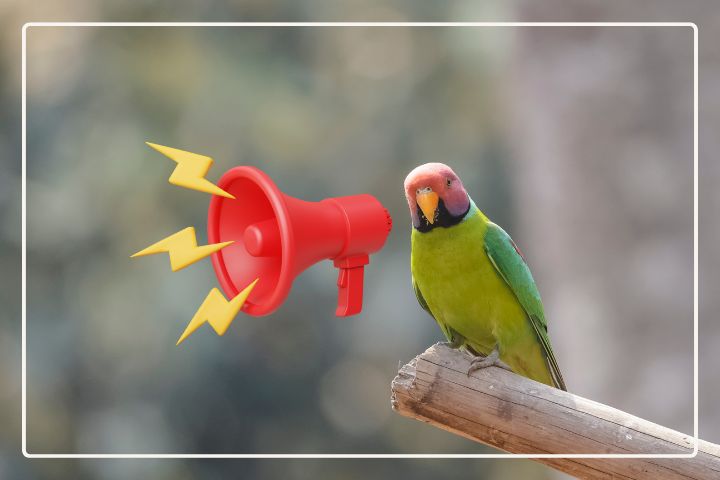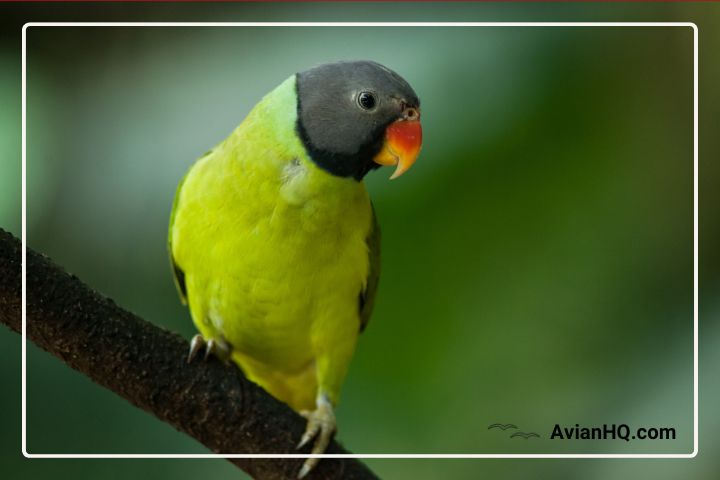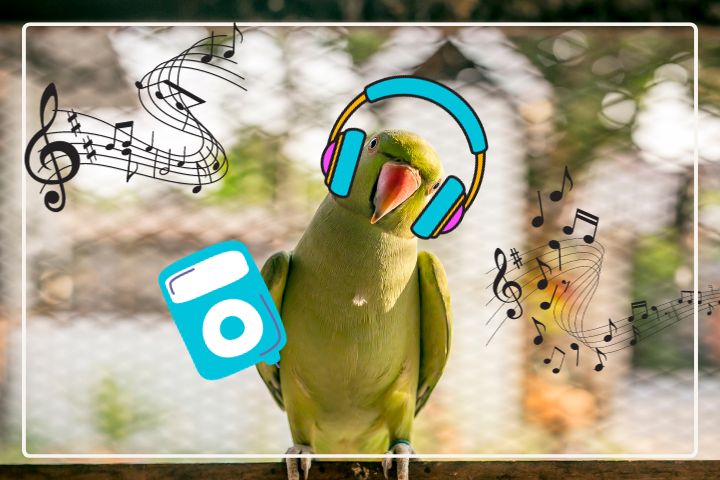Are Plum Headed Parakeets Loud?
When it comes to pet birds, noise is often a top concern for owners and neighbors alike. Among parrots, some species have gained notoriety for ear-piercing shrieks and relentless squawking. But what about the plum-headed parakeet? Do these brilliant green birds deserve their reputation, or are they a quieter companion?
The answer, thankfully, is a nuanced one. Plum-headed parakeets are not silent pets that will blend seamlessly into an apartment soundscape. Their excitable chatter and shrill contact calls ensure a definite avian presence. However, their moderate volume also makes them far from the loudest parrots around. Compared to screaming cockatoos or relentless conures, a plum head’s contact calls seem subdued. And unlike some parrots, they do not vocalize nonstop when awake.
So while plum heads have a voice, their noises are intermittent and reasonably toned down. For owners hoping for a parrot muted enough for apartment living, the plum head can be an excellent compromise. Proper training and care does wonders to minimize noise issues as well.
In this article, we will cover everything potential plum head owners need to know about noise levels. From decibel comparisons to the times of day calls are most frequent, you will get a full profile of their vocal habits. We will also provide actionable tips to curb excessive loudness when possible. By the end, you will know whether these brilliant parakeets are a good acoustic match for your home and lifestyle.
How Loud are Plum Headed Parakeets?
Among parrots, plum-headed parakeets occupy a moderate position for noise levels. Their typical vocalizations register around 68 decibels. To put that in perspective, normal human conversation also averages around 60-70dB. The ambient noise on a busy street can reach 85dB.
So while the shrill tones of a plum head may seem piercing up close, their baseline volume remains reasonable. The noise certainly does not reach dangerous levels that can damage hearing, unlike macaw shrieks that soar over 100dB.
And importantly, plum heads do not maintaining a constant stream of noise throughout the day. Their vocalizing comes in energetic spurts when excited, but remains sparse when calm. The most frequent chatter occurs when they are out of the cage playing. At night or when resting, plum heads remain relatively quiet.
So potential owners should not equate these parakeets with species notorious for nonstop screaming. Their intermittent vocalizing remains at manageable levels overall. However, their excitable nature does ensure they are not a silent pet either. The noises can be loud when close by, especially when perched on one’s shoulder. But proper care keeps their volume within acceptable limits for most owners.
Noise Level Comparison to Other Birds
To better understand the plum head’s moderate noise levels, it helps to compare them to both quieter and louder birds.
On the lower end, parrotlets produce just 65dB of noise. That makes them quieter than ambient dishwasher operation, and their muted sounds generally suit apartment living.
Budgies and cockatiels also tend to be less noisy than plum heads at around 70dB. Owners describe their vocalizations as a pleasant background chatter.
In contrast, large parrots like macaws and cockatoos often reach ear-splitting levels over 100dB. Even conures and Amazons in the mid-80dB range may be too shrill for some owners.
So at 68dB, the plum head’s intermittent vocalizing occupies a middle ground. They are louder than a mellow Caique, but remain far more subdued than a screaming Moluccan cockatoo.
Noise Level Comparison to Other Sounds
To put the plum head’s 68dB chatter into everyday perspective, here are some common sounds and their decibel levels:
- Library: 30dB
- Rainfall: 50dB
- Bird Song: 60dB
- Vacuum Cleaner: 70dB
- Blender: 80dB
- Traffic: 85dB
- Subway Train: 90dB
- Motorcycle: 95dB
- Power Saw: 105dB
- Ambulance Siren: 120dB
In a quiet home setting, the plum head’s vocalizations are similar in volume to a vacuum cleaner or blender running in the background. Their noise levels blend in like a noisy appliance.
In a busy urban area with street traffic, the parakeet’s calls likely fade into the environmental din. Only very loud motorcycles and sirens would drown them out completely.
So while they may seem loud up close, plum heads produce an intermittent 68dB chatter that mixes into most ambient soundscapes. Compared to screaming cockatoos or big macaws that easily overpower background noise, the plum head’s vocal volume remains modest for a parrot.
With reasonable expectations that they are not silent pets, but not overly loud either, plum heads can thrive noise-wise in most home environments. Some basic training can help minimize any excessive loudness as well.
Why Do Plum Headed Parakeets Make Noise?
To coexist happily with a vocal plum head, it helps to understand why they make noise in the first place. Parrot sounds may seem like random loud chatter to us, but serve important purposes for them:
Mental Stimulation
Parrots are incredibly intelligent and require constant mental stimulation. Making noises, mimicking sounds, and “talking” helps keep their active brains engaged and healthy. So in a sense, the vocalizing results from a plum head keeping itself entertained!
Communication
Parrots use contact calls to communicate within their flock. Plum heads in particular have an excitable, social nature. Chatter between flock members conveys information and emotional states. So some vocalizing comes from a plum head simply keeping in touch with their owners!
Mimicry
Parrots mimic noises as a form of play and bonding. By repeating sounds they hear around them, plum heads integrate into their social environment. The same parts of their brain process mimicry and motion – which explains why some parrots will “dance” to music!
Happiness
Like humans cheerfully singing in the shower, parrots will vocalize and chatter more when in a positive mood. So increased noise can actually indicate a happy, healthy plum head!
Natural Sounds
Parrots make certain natural calls to express their current state, such as squawks, chirps, and shrill alarm calls. Plum heads have a range of innate “words” in their vocabulary to communicate needs.
The sounds of a plum head ultimately provide cognitive enrichment, social connection, emotional expression, and insight into their well-being. Knowledge of the purposes behind parrot noise can help owners embrace it as a natural part of living with these intelligent, vocal birds.
When are Plum Headed Parakeets the Loudest?
While plum heads vocalize intermittently all day, certain times tend to bring out more excited vocalizing:
Morning Wakeup
Like humans, plum heads awaken bright-eyed and bushy-tailed – and loud! Expect an energized chorus first thing in the morning as they start their day.
Playtime
When out of the cage playing and interacting, expect elevated chatter as they socialize. The most constant vocalizing occurs during their daily exercise.
Mealtimes
Food excites parrots, so singing for their supper with a round of calls is common at meals. This often continues for a while after eating as well.
Evenings
Many parrots experience a uptick in activity levels in the evening hours. This can translate to more vocalizations before bedtime.
Your Arrival Home
Plum heads are highly social and bond closely with owners. Expect excited screaming and chatter when their flock-mate returns home after an absence.
Interacting with Owners
Perching on their owner’s shoulder seems to elicit chatter as they bond. And any direct playtime and interaction brings out more vocalizing as well.
Knowing these patterns allows owners to anticipate noisier periods and mitigate excess volume when possible. But in general, their baseline chatter remains at reasonable levels.
How to Make Plum Headed Parakeets Quieter
While plum heads have natural vocalization needs, excess noise can still be minimized with proper training and care:
Baths
Bizarre as it sounds, baths tend to calm parrots and temporarily reduce vocalizing. Providing regular water baths gives a welcome period of quiet.
Toys
Keeping their agile minds engaged with foraging and shredder toys helps prevent boredom induced noise. Rotate new toys regularly to pique their interest.
Food
Their beaks can’t squawk when full! Providing food at peak noise times occupies their mouth and distracts them.
Positive Reinforcement
Reward quiet behavior with treats and praise. Ignore or briefly leave the room for loud outbursts to discourage the association.
Set Expectations
Let them know certain times of day are for loud chatter, while others require polite volume. Consistency is key.
Companionship
Plum heads are social flock birds. More interaction and companionship from owners minimizes noise stemming from isolation.
White Noise
Creating ambient background noise with fans or music can help muffle excessive vocalizing when needed.
Limitations
While the above techniques can help curb excessive noise, they have their limits:
- Plum heads cannot be entirely silent pets. Some vocalizing will always occur naturally.
- Their innate contact calls and flock communication noises cannot be eliminated. This serves important social functions.
- Sounds expressing excitement, happiness, or alarm may be unavoidable. These reflect their emotional state.
- Total noise avoidance could negatively impact the bird’s welfare and sociability. Some chatter is normal parrot behavior.
- What owners perceive as “loud” is subjective. Absolute noise suppression usually backfires.
- Each bird has a unique personality influencing noise levels. Not all plum heads are identical.
So while training helps mitigate truly disruptive noise, their main communication vocalizations cannot and should not be stopped completely. Judicious expectations are key for a good fit in apartments.
Read Next: Where Do Plum Head Parrots Come From?
Can Plum Headed Parakeets Stay in Apartments?
Given their moderate noise levels, plum heads can make excellent apartment companions with proper precautions:
- Their intermittent vocalizing is not excessive enough to disturb most neighbors.
- Apartment soundproofing and ambient noise helps muffle parrot calls.
- Proper cage placement away from shared walls reduces noise transfer.
- Morning and night routines minimize early/late disturbances.
- Training plum heads on acceptable noise times sets clear expectations.
- Keeping their active minds engaged reduces boredom related chatter.
- Providing companionship opportunities while away prevents loneliness noise.
Plum heads generally adapt well to apartment living with conscientious care and training. However, always ensure the specific bird’s personality and activity needs are a good match before adopting. The key is reasonable expectations – plum heads chatter, but not to problematic levels with proper management. Discussing plans with landlords also minimizes issues down the road.
Conclusion
For potential plum head parakeet owners, noise is often the top concern when considering these vibrantly vocalized birds. However, their moderate 68dB vocalizing proves both manageable for most owners, and reasonably apartment-friendly.
While far from silent, plum heads do not scream relentlessly like some intolerably loud parrots. Their chatter occurs in energetic bursts but remains intermittent when calm or sleeping. And simple training and care strategies can curb bothersome noise when needed.
So prospective owners should not equate plum heads with notoriously loud parrot species. Their excitable vocalizing is a manageable aspect of properly caring for these engaging birds. With realistic expectations of their natural noise levels, plum headed parakeets can make wonderfully endearing companions both in apartments and houses. Just be sure to provide adequate mental stimulation and socialization to keep their chatter at acceptable volumes.







I love your writing style genuinely enjoying this website .